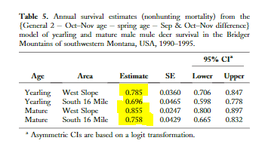willfrye027
WKR
- Joined
- Dec 4, 2018
- Messages
- 2,333
Couldn’t agree more. Aside from doe tags, any other hunting season change is just managing hunters and does not affect the herds trajectory. You might be able to manage for some larger deer on the landscape, but the herd will not grow.Guys.... I would deeply caution you all to not make major changes to the season structures when you have incomplete information.
Mandatory harvest reporting and reduction of B tags would go a long ways and would get you more information to make a more educated change. Those are easy to communicate to FWP and implement in short time. Detailed harvest reporting data will then allow you to make a possibly much better proposition in the future.
Don't mess it up when you don't hold all the cards and will never be able to undo it....
If you are a trophy hunter you should WANT everyone else to shoot yearling bucks. Half of them die of “natural causes” anyways. When that greedy NR punches his tag, he goes home and is not competing with you. Forkies are an expendable resource and if a guy wants to have fun and come home with a buck, it should not bother you.
I wish we could have better hunting and bigger bucks for everyone by changing some rules and seasons..but it’s not going to happen. It’s failed everywhere in the west despite plenty of variations.
Calm down, let this mule deer slump pass, and reevaluate after a few years of favorable conditions.


